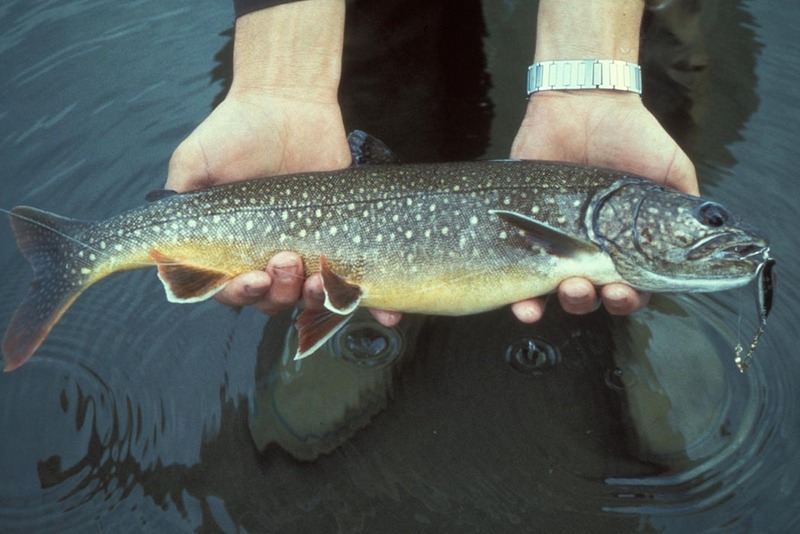|
| Query: trout | Result: 1st of 327 | |
Lake Trout (Salvelinus namaycush) - Wiki
| Subject: | Lake Trout (Salvelinus namaycush) - Wiki
| |

| Resolution: 1050x701
File Size: 96639 Bytes
Upload Date: 2007:08:12 23:49:30
|
Lake trout
From Wikipedia, the free encyclopedia
[Photo] Lake Trout, Salvelinus namaycush. Creator: U.S. Fish and Wildlife Service
Lake trout (Salvelinus namaycush) is a freshwater char living mainly in lakes in northern North America. Other names for it include mackinaw, lake char (or charr), touladi, togue, and grey trout. Lake trout are prized both as game fish and as food fish.
Lake trout are the largest of the trouts, the record weighing almost 46.3 kg (102 lb). They were fished commercially in the Great Lakes until lampreys, overharvest and pollution extirpated or severely reduced the stocks. Commercial fisheries still exist in some smaller lakes in northern Canada.
Lake trout are dependent on cold, oxygen-rich waters. They are pelagic during the period of summer stratification in dimictic lakes.
The lake trout is a slowly growing fish, typical of oligotrophic waters. It is also very late to mature. Populations are extremely susceptible to overexploitation. Many native lake trout populations have been severely damaged through the combined effects of hatchery stocking (planting) and overharvest.
It is generally accepted that there are two basic types of lake trout populations. Some lakes do not have pelagic forage fish during the period of summer stratification. In these lakes, lake trout take on a life history known as planktivory. Lake trout in planktivorous populations are highly abundant, grow very slowly and mature at relatively small size. In those lakes that do contain deep water forage, lake trout become piscivorous. Piscivorous lake trout grow much more quickly, mature at a larger size and are less abundant. Notwithstanding differences in abundance, the density of biomass of lake trout is fairly consistent in similar lakes, regardless of whether the lake trout populations they contain are planktivorous or piscivorous.
From a zoogeographical perspective, lake trout are quite rare. They are native only to the northern parts of North America, principally Canada but also Alaska and, to some extent, the northeastern United States. Lake trout have been introduced into many other parts of the world, mainly into Europe but also into South America and certain parts of Asia. In Canada, approximately 25% of the world's lake trout lakes are found in the province of Ontario. Even at that, only 1% of Ontario's lakes contain lake trout.
Lake trout have been known, very rarely, to hybridise in nature with the brook trout but such hybrids are almost invariably reproductively sterile. Hybrids are also artificially propagated in hatcheries and then planted into lakes in an effort to provide sport fishing opportunities.
The specific epithet namaycush derives from an indigenous North American name for the species, most likely in one of the Algonquian languages (c.f. Ojibwe: namegos = "lake trout"; namegoshens = "rainbow trout").
http://en.wikipedia.org/wiki/Lake_trout
| The text in this page is based on the copyrighted Wikipedia article shown in above URL. It is used under the GNU Free Documentation License. You may redistribute it, verbatim or modified, providing that you comply with the terms of the GFDL. |
|
Comments |
|---|
| | Guest |
|
Scientific Name: Salvelinus namaycush (Walbaum, 1792)
Common Names: Lake Trout, Great Lake Trout, Mackinaw Trout, Mountain Trout, Togue, Siscowet, Touladi [French]
Synonyms:
Cristivomer namaycush (Walbaum, 1792)
Cristovomer namayacush (Walbaum, 1792)
Salmo amethystinus Mitchill, 1818
Salmo amethystus Mitchill, 1818
Salmo confinis DeKay, 1842
Salmo ferox Perley, 1852
Salmo namaycush Walbaum, 1792
Salmo pallidus Rafinesque, 1817 |
^o^
Animal Pictures Archive for smart phones
^o^
|
|
|